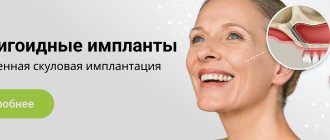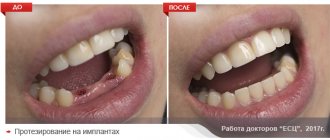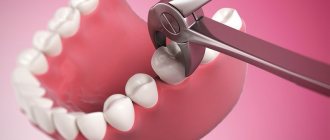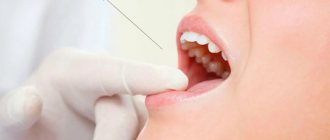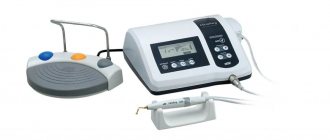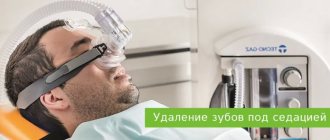- Questions and answers
- Stock
- Reviews
To make the treatment as painless and comfortable for the patient as possible, anesthesia is performed. Dentists at NovaDent clinics in Moscow and the region use drugs that guarantee quick and reliable results. The price of anesthesia will have almost no effect on the overall cost of the procedure, but will ensure a comfortable visit to the dentist, relieving the patient of fear and stress.
General anesthesia in modern dentistry
Sedation is a type of anesthesia that involves the use of sedatives to put the patient into a state of light sleep. This anesthesia allows you to:
- Increase the threshold of pain sensitivity.
- Place the patient in a state of semi-sleep from which awakening occurs easily. The patient hears the doctor's words and can react to them.
- To extract a tooth from a patient who has an irresistible gag reflex.
- Treat people who have had a heart attack or stroke, as well as patients with high blood pressure.
- Relieve the patient of stress while in the dental chair - sedation provides complete physical and emotional comfort and eliminates the feeling of fear. This method of pain relief will help the patient interact with the doctor if necessary.
Sedation combined with local anesthesia allows the patient to relax and undergo the tooth extraction procedure without pain. This anesthesia is especially effective in the case of long-term and extensive surgery - removal of wisdom teeth.
It is better to entrust the extraction of teeth of increased complexity or in preparation for implantation to an oral and maxillofacial surgeon. The healing time and the ability to install an implant without additional bone augmentation operations depend on how carefully the removal is carried out. Average surgeons do not stand on ceremony with the remaining teeth. The result is broken bone structures of the jaw, wandering remnants of roots, unremoved cysts growing into the maxillary sinus, perforations, fistulas, osteomyelitis and much more. Not to mention the shocking post-operative pain that overtakes the patient after such punitive surgery. Only the maxillofacial surgeon has enough theoretical and practical skills to perform tooth extraction without complications.
Types of sedation:
- Pharmacological (for adult patients) involves the administration of sedative drugs of the latest generation intravenously.
- Oxygen (for babies) - a nasal mask is put on. The baby breathes into it, falling into a shallow sleep. Awakening occurs immediately as soon as the little patient takes off the mask.
Both types of pain relief serve the same purpose - to help the patient relax and get rid of the fear of surgery.
Sedation involves the use of non-toxic drugs that are easily eliminated by the body. However, the procedure is not permitted for all patients. Sedation is contraindicated:
- patients with allergies to local anesthetics;
- those suffering from neuromuscular disorders (myasthenia gravis);
- expectant mothers during all months of pregnancy;
- in case of alcohol or drug intoxication.
If there are no contraindications listed above, sedatives can be used for any dental procedures, from caries treatment to implantation.
There are also contraindications for sedation in children using nitrous oxide:
- the patient is under three years of age;
- the presence of rhinitis, runny nose and cough;
- epilepsy.
When extracting teeth in young patients with Down syndrome or autism, the use of sedatives alone is often not enough - the doctor also uses anesthesia.
Related articles:
- Important questions about anesthesia and sedation
- Tooth extraction under sedation
- Cost of sedation
- Medication-induced sleep in dentistry
What are the differences between the main types of pain relief?
Application anesthesia is a type of local anesthesia. The essence of this anesthesia is that instead of an injection, a special agent in the form of a gel or spray with an anesthetic is applied to the oral mucosa. Used for minor interventions. It is often used before general anesthesia, for example, in case of discomfort during professional oral hygiene. Duration of application anesthesia - no more than 30 minutes
Infiltration anesthesia is also a type of local anesthesia, the most commonly used type of anesthesia. The injection helps to minimize the sensitivity of a specific area in the oral cavity. The drug is injected into the gums or into the mucous membrane of the cheek, where one or more teeth requiring treatment are located. Action time is 3-4 hours.
Conduction anesthesia - used during complex surgery, is also a type of local anesthesia, the only difference is in the place of application. The drug is administered in close proximity to the nerve endings, the action time is up to 5-6 hours.
Sedation - this method of pain relief allows you to relieve the patient’s emotional stress, relieves fear and panic. Using a rotomer, a mixture of nitrous oxide and oxygen enters the body. Inhaling vapors through the nose relaxes the patient, a feeling of calm sets in, and the state resembles drowsiness. The patient is conscious, sees everything, understands, but does not concentrate on the pain sensations, due to this they are dulled. Sedation is not anesthesia in the full sense of the word; it is used exclusively in combination with local anesthesia.
General anesthesia - the essence is the inhibition of the central nervous system, when the patient’s consciousness “turns off”. He does not feel pain, the muscles are completely relaxed, there is no stress and negative emotions. The anesthesiologist selects the appropriate type of anesthesia individually for each person, based on the general condition of the patient. Recovery from general anesthesia lasts about 4 hours.
It is worth noting once again that for such common procedures as wisdom tooth removal, treatment of deep caries, pulp removal, the infiltration method of anesthesia is most often chosen.
Preparing for sedation and recovering from light sleep
The use of sedatives makes it possible to painlessly remove teeth even in patients who have had a heart attack. This type of pain relief does not require complex preparatory measures, but a little precaution will not hurt:
- Avoid drinking alcohol 24 hours before the procedure;
- do not eat, do not drink coffee or strong tea 3-6 hours before surgery;
- an examination by an anesthesiologist on the day of treatment is required;
- During the procedure, the patient's pulse, blood pressure and respiratory rate are measured.
If the patient suffers from chronic diseases and takes medications on an ongoing basis, then he should discuss this issue in advance with the anesthesiologist. During the procedure, harmless substances are used that do not have a narcotic effect, but extra precautions will not hurt.
Tooth extraction under sedation is carried out under the constant supervision of an anesthesiologist. Attentiveness, monitoring and timely correction of body parameters makes the procedure 100% safe.
After tooth extraction, the patient should not drive a car, as sedatives slow down the reaction rate. Dentists recommend leaving the clinic only if accompanied by other people.
Sedation: indications and features of implementation
Sedation is a gentler alternative to general anesthesia. During dental treatment under sedation, the patient is in a light nap, which makes the procedure quick and as comfortable as possible. As a result of the administration of sedatives, a person’s consciousness is dulled, but he can be awakened at any time. Among the main indications for this procedure are:
- Serious psychological discomfort, fear and severe anxiety;
- Irresistible gag reflex;
- Hypertension;
- Allergy to anesthesia;
- High blood pressure;
- The need for long-term treatment;
- A history of stroke or heart attack.
The patient's condition is closely monitored by an anesthesiologist during dental procedures. At the same time, cardiac monitoring is carried out using modern devices. In most cases, after waking up, the patient does not immediately realize that the worst is over. In the first hours after the sedatives wear off, many people note a pleasant relaxation throughout the body and slight drowsiness. As a result, going to the dentist turns into a useful and at the same time enjoyable pastime.
Features of tooth extraction under general anesthesia
Due to fear of pain, many people put off visiting the dentist until a critical situation occurs. General anesthesia makes the surgical intervention imperceptible, since during the procedure the patient will be in a state of deep sleep.
There are two methods of pain relief:
- The injection method involves the use of sodium thiopental and propofol to perform short-term dental procedures. The duration of sleep can be increased if difficulties arise during the procedure.
- The inhalation method is used when performing complex surgical interventions, which, moreover, are lengthy.
The use of both methods of pain relief must be justified. General anesthesia is necessary for:
- The patient has an allergic reaction to anesthetics.
- Difficult removal or large volume of planned intervention.
- Maxillofacial surgeries (for example, sinus lift). So that the patient does not suffer from discomfort when sitting for a long time on the dental chair and is not afraid of the doctor’s bloody working instruments, he is put into deep sleep.
- The patient has mental disorders. It is impossible to predict the behavior of such a patient. To prevent harm to himself or the doctor, general anesthesia is used.
- A pronounced gag reflex in the patient.
At first glance, tooth extraction under general anesthesia is the most comfortable and enjoyable procedure for the patient, since he does not feel fear or pain during dental procedures. In fact, not everything is so happy. The use of general anesthesia is contraindicated:
- Epileptics.
- People who have had a heart attack or stroke.
- Suffering from bronchial asthma or pneumonia.
- Patients under the influence of alcohol or drugs.
- People who suffer from acute inflammation.
- Pregnant women, especially during the first and last trimesters.
If the patient is not at risk and does not take medications on an ongoing basis, then tooth extraction can be performed under general anesthesia. Comfort and the absence of even minimal pain are the main advantages of this method of pain relief. The patient will not get tired of keeping his mouth open and will not prevent the dentist from completing the procedure with his inadequate reaction to bloody instruments and unpleasant sensations.
General anesthesia is dangerous to health - is this true?
Preparations for general anesthesia do not consist of vitamins, but they cannot be called dangerous either. We use only certified, non-toxic materials that are quickly and completely removed from the body. In addition, general anesthesia is not used just like that; it is used in cases where tooth extraction without it will cause several times more harm than the anesthesia itself.
I saw a film where a man woke up during anesthesia and felt everything, but could not move. What if this happens to me too?
Such a plot is interesting, entertaining, successful with viewers, and due to the frequency of its use, it seems that this happens to every second patient. Actually no, intraanesthesia awakening rates are less than one percent! This happens due to the wrong combination of drugs - the sleeping pills stop working earlier, so the person wakes up, but cannot move. In modern medicine, such errors are excluded; the dose is calculated individually. In addition, the anesthesiologist monitoring the patient will notice changes in indicators and stop the operation.
Recovery from anesthesia and postoperative period
Tooth extraction under general anesthesia is a serious surgical intervention that cannot be performed without careful comprehensive preparation. At this stage, it is important to determine whether the patient has contraindications to the procedure.
Preparation for surgery under general anesthesia involves:
- consultation with a neurologist and therapist to identify contraindications to medications;
- mandatory informing the anesthesiologist about all medications the patient is taking;
- avoiding drinks 4 hours before surgery;
- last light meal 6 hours before the procedure;
- quit smoking 12 hours before tooth extraction, and quit alcohol at least 24 hours before.
Tooth extraction using general anesthesia cannot be called a completely safe procedure.
The following side effects are possible after using the drugs:
- dizziness;
- irritability;
- problems with concentration;
- weakness;
- increased blood pressure;
- convulsions;
- nausea.
This list of complications is not exhaustive. In rare cases, cardiac and respiratory activity may be impaired, and then resuscitation measures cannot be avoided.
As with the use of sedatives, patients who have undergone surgery under general anesthesia are not recommended to drive or leave the medical facility unaccompanied.
Features of the postoperative period:
- first meal - 4 hours after surgery or even later;
- on the day of surgery, the patient should refuse a hot bath, sauna or bath;
- The patient should not drink alcohol or smoke for 24 hours;
- You can brush your teeth on the second day after extraction;
- for 2-3 weeks you should not touch the hole with your tongue or fingers.
If the patient follows all the surgeon’s recommendations, the recovery process after surgery will not cause additional discomfort. In case of severe pain, the patient is prescribed an injection of an anesthetic drug.
Benefits of pain relief during tooth extraction
At first glance, both sedation and general anesthesia involve performing surgery while you sleep. However, the effect of sedatives can be compared to dozing, and anesthesia to a deep sleep from which you cannot wake up immediately.
The main goal of any pain relief is to create a comfortable environment for the patient. Advantages of general anesthesia:
- 100% painless - the patient does not experience any discomfort.
- Lack of psychological stress - this method allows you to remove teeth from patients with dental phobia.
- Possibility of performing complex operations - the doctor is not afraid that the patient will feel pain during the removal of wisdom teeth and prevent him from completing the procedure.
- Excluding accidental injuries - nothing will prevent the dentist from carrying out his duties responsibly.
- Safety - an experienced anesthesiologist monitors the patient’s condition throughout the entire procedure.
Sedation is a more expensive method of pain management during tooth extraction. The high cost of the service is explained by the fact that the anesthesiologist uses drugs that have no consequences for the body. That is, after sedation, increased blood pressure, seizures and other negative consequences are excluded.
Sedatives allow the patient to calm down, eliminate a strong gag reflex and painlessly undergo the tooth extraction procedure. If necessary, the patient will easily and quickly follow all the surgeon’s instructions. The patient will not have to recover for a long time after the operation.
The cost of dental services usually depends on:
- volume of surgical intervention;
- type of removal (complicated or uncomplicated);
- characteristics of the body.
Trusted dental clinics negotiate the cost of removal with the patient in advance and record this information in the documentation.
Features of tooth extraction in pregnant women
When a woman is expecting a baby, she needs to be especially careful about her health. During pregnancy, it is advisable to refrain from surgical interventions. If a tooth needs to be removed urgently, then the procedure should be carried out only in agreement with the patient’s gynecologist and therapist.
Features of tooth extraction in expectant mothers:
- sedation and general anesthesia cannot be used as types of pain relief;
- the effect of local anesthetics on the fetus is minimal;
- surgical intervention is performed only in the second trimester;
- It is not recommended to take x-rays - to get a picture of the tooth, a radiovisiograph is used;
- the prescription of medications must be strictly justified and dosed, taking into account the duration of treatment and the patient’s condition.
Wisdom teeth in pregnant patients are not removed at all, since after the procedure a deterioration in health is possible (inflammation of the socket and increased body temperature). Simple surgery can only be done if the pain is severe.
Tooth extraction in pregnant women is carried out between 13 and 32 weeks of pregnancy. If there is no urgent need, then it is better to postpone the procedure.
